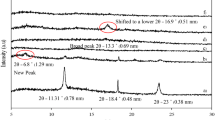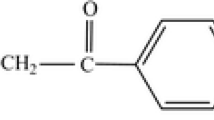Abstract
A phenomenological analysis on desorption mechanism of lemon essential oil in semicrystalline polymer nanocomposites is performed. Films were made of polypropylene and talc nanoparticles obtained by blown extrusion were used as a case study due to the high complexity of sorption phenomena in such systems containing a semicrystalline polymer and nucleating particles. In this sense, a systematic analysis combining both morphological effects and intrinsic properties of each component was considered. Talc characteristics, e.g., morphology, surface chemistry, oil absorption properties, mean particle size and its distribution, and impurity presence, were considered in desorption analysis. Regarding semicrystalline matrix, morphological and crystalline changes induced by talc nanoparticles and processing were included in this study. Desorption of lemon essential oil from nanocomposite films with different talc concentrations (0, 1, and 5 wt%) which have distinctive and well characterized morphologies was evaluated through gravimetric and thermogravimetric analysis. Results show that polypropylene film has a desorption rate higher than nanocomposites containing 5 wt%, but lower than those with 1 wt% talc. This behavior is a consequence of the global crystallinity configuration changes produced by nanoparticle concentration and film obtaining process. It is revealed that simplified and conventional approaches that consider tortuosity as unique effect of particle presence in nanocomposite mass transport do not allow to comprehend the desorption mechanism involved in a complex system such as the semicrystalline polymer nanocomposites. The present study gives additional insight into the complex mechanism involved in desorption of strongly swelling oil in nanocomposite films based on semicrystalline polymers and mineral nucleating particles.




Similar content being viewed by others
References
Ebnesajjad S (2013) Plastic films in food packaging: materials, technology and applications. Elsevier, Waltham
Robertson GL (2013) Food packaging: principles and practice. CRC Press, London
Arab-Tehrany E, Gonzalez LS (2015) Transfer phenomena in food/packaging system. Functional polymers in food science: from technology to biology. Wiley, New Jersey. doi:10.1002/9781119109785.ch3
Kilcast D, Subramaniam P (2000) The stability and shelf-life of food: introduction. Woodhead Publishing Ltd., Cambridge
Moreira MR, Alvarez MV, Ponce AG (2016) Essential Oils. Postharvest management approaches for maintaining quality of fresh produce. Springer, Berlin
Maisanaba S, Llana-Ruiz-Cabello M, Gutiérrez-Praena D, Pichardo S, Puerto M, Prieto AI, Jos A, Cameán AM (2016) New advances in active packaging incorporated with essential oils or their main components for food preservation. Food Rev Int. doi:10.1080/87559129.2016.1175010
Quezada Gallo JA, Debeaufort F, Voilley A (1999) Interactions between aroma and edible films. 1. Permeability of methylcellulose and low-density polyethylene films to methyl ketones. J Agric Food Chem 47:108–113
Maier C, Calafut T (1998) Polypropylene. The definitive user’s guide and databook. William Andrew Inc., Norwich
Campos-Requena VH, Rivas BL, Pérez MA, Pereira ED (2016) Short and long-term loss of carvacrol from polymer/clay nanocomposite film—a chemometric approach. Polym Int 65:483–490
Alshabanat M (2013) Characterization and mechanical properties study of intercalated talc/polypropylene nanocomposites. J Am Sci 9:322–326
Ferrage E, Martin F, Boudet A, Petit S, Fourty G, Jouffret F, Micoud P, De Parseval P, Salvi S, Bourgerette C, Ferret J, Saint-Gerard Y, Buratto S, Fortune JP (2002) Talc as nucleating agent of polypropylene: morphology induced by lamellar particle addition and interface mineral-matrix modelization. J Mater Sci 37:1561–1573
Carretero MI, Pozo M (2010) Clay and non-clay minerals in the pharmaceutical and cosmetic industries Part II. Active ingredients. Appl Clay Sci 47:171–181
Casanova H, Orrego JA, Zapata J (2007) Oil absorption of talc minerals and dispersant demand of talc mineral non-aqueous dispersions as a function of talc content: a surface chemistry approach. Colloids Surf A Physicochem Eng Asp 299:38–44
Castillo LA, Barbosa SE, Capiati NJ (2013) Surface-modified talc particles by acetoxy groups grafting: effects on mechanical properties of polypropylene/talc composites. Polym Eng Sci 53:89–95
Castillo LA, Barbosa SE, Capiati NJ (2012) Influence of talc genesis and particle surface on the crystallization kinetics of polypropylene/talc composites. J Appl Polym Sci 126:1763–1772
Choudalakis G, Gotsis AD (2009) Permeability of polymer/clay nanocomposites: a review. Eur Polym J 45:967–984
Moaddeb M, Koros WJ (1995) Effect of orientation on the transport of d-limonene in polypropylene. J Appl Polym Sci 57:687–703
Gañán NA (2014) Extracción y fraccionamiento de biocidas de origen natural mediante el uso de fluidos supercríticos. Ph.D. Thesis, Universidad Nacional del Sur, Bahía Blanca, Argentina
Espinosa K, Castillo L, Barbosa S (2016) In: Grumezescu AM (ed) Nanotechnology in agri-food industry (multi-volume SET I–X) volume VII: food packaging, 1st edition, ISBN: 9780128043028. Elsevier (Academic Press), Cambridge, USA. http://store.elsevier.com/Food-Packaging/isbn-9780128043028/
Marinelli AL, Bretas RES (2003) Blends of polypropylene resins with a liquid crystalline polymer. I. Isothermal crystallization. J Appl Polym Sci 87:916–930
Rybnikář F (1989) Orientation in composite of polypropylene and talc. J Appl Polym Sci 38:1479–1490
Zaikov GE, Mikheev YA (2005) Kinetics and mechanisms of chemical reactions. Nova Science Publishers Inc, New York
Anthony Liu C-PS, Nguyen DC, Neogi P (1990) Effects of constrained chain conformations on polymer-solute interactions in semicrystalline polymers. J Macromol Sci Phys B 29:203–220
Kucera M (2013) Industrial minerals and rocks: developments in economic geology. Elsevier Science, New York, p 1984
Koshida T, Kumagai M, Hiwasa S (2015) US Patent US20150209248 A1
DeArmitt C, Hancock M (2003) In: Rothon RN (ed) Particulate-filled polymer composites. Rapra Technology Limited, Shrewsbury
Hancock M, Rothon RN (2003) In: Rothon RN (ed) Particulate-filled polymer composites. Rapra Technology Limited, Shrewsbury
Ray SS, Okamoto M (2003) Polymer/layered silicate nanocomposites: a review from preparation to processes. Prog Polym Sci 28:1539–1641
Manias E, Polizos G, Nakajima H, Heidecker MJ (2007) In: Morgan AB, Wilkie CA (eds) Flame retardant polymer nanocomposites. Wiley-Interscience, Hoboken
Zheng XY, Ding H, Mei FL, Zhu XY, Wang MM (2012) Preparation and property characterization of talc/phthalocyanine blue composite powder. Key Eng Mat 512–515:239–244
Karacan I, Benli H (2011) An X-ray diffraction study for isotactic polypropylene fibres produced with take-up speeds of 2500–4250 m/min. Tekstil ve Konfeksiyon 21:201–209
Addink EJ, Beintema J (1961) Polymorphism of crystalline polypropylene. Polymer 2:185–193
Author information
Authors and Affiliations
Corresponding author
Rights and permissions
About this article
Cite this article
Alonso, Y.N., Grafia, A.L., Castillo, L.A. et al. Lemon essential oil desorption from polypropylene/talc nanocomposite films. Iran Polym J 25, 999–1008 (2016). https://doi.org/10.1007/s13726-016-0485-x
Received:
Accepted:
Published:
Issue Date:
DOI: https://doi.org/10.1007/s13726-016-0485-x




